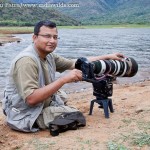IndiaWilds Newsletter Vol. 2 Issue IV
I believe it is a good idea to do benchmarking; after all, life is all about change for the better. In the IndiaWilds Newsletter Vol. 1 Issue XI (http://www.indiawilds.com/diary/indiawilds-newsletter-vol-1-issue-xi), I had done a comparison between wildlife sanctuaries in India and Africa focusing on the size. Continuing with the efforts in analyzing best practices from Africa, in this edition we focus on eco-tourism.
Ecotourism:
Ecotourism is a much reviled concept in India. Most often the word is used liberally and twisted to suit the needs of different groups like forest department, NGOs, settlers in a wilderness area etc.
IUCN has defined ecotourism, as “environmentally responsible travel and visitation to relatively undisturbed natural areas, in order to enjoy, study and appreciate nature (and any accompanying cultural features – both past and present), that promotes conservation, has low negative visitor impact, and provides for beneficially active socio-economic involvement of local populations”.
Ecotourism has got different degrees of success around the world. Like any other tool, it has its own limitations and is definitely not the panacea of all ills afflicting our wilderness areas. Let us look at ecotourism as it is practiced or preached in India.
Ecotourism Strategy
Do we have an ecotourism strategy? What do we expect from ecotourism? Have we done any objective setting for ecotourism in India?
Unfortunately, the answer is no. The sporadic efforts of some genuinely interested individuals and groups may have resulted in a few so called “successful” ecotourism operations. However, as a country we are groping in the dark.
In sharp contrast Botswana, one of the poorest countries in Africa (as far as measurement of economy in the traditional method is concerned) has defined its ecotourism strategy and objectives. It would be pertinent to mention that Botswana has got 37% (thirty seven percent) of its landmass in National Parks, Nature Reserves and Wildlife Management Areas. Ecotourism objectives of Botswana:
- Minimizing negative social, cultural and environmental impacts.
- Maximizing the involvement in, and the equitable distribution of economic benefits to, host communities.
- Maximizing revenues for re-investment in conservation.
- Educating both visitors and local people as to the importance of conserving natural and cultural resources
- Delivering a quality experience for tourists
Where do we stand if we analyse ourselves with a similar set of objectives?
How environment friendly is our ecotourism?
There are too many groups to talk about social and cultural impact. I would limit my observations to the environmental impact.
- Do we use energy and water conservation technologies to save our precious resources?
- Do we use local design and construction methods?
- Do we practice responsible waste management measures?
- How do we eliminate hazardous materials, pesticides, phosphate based cleaners, solvents, Volatile organic compounds etc?
- Do we assess life-cycle environmental impacts of all building materials and purchases associated with ongoing operations and maintenance
- Fresh food purchased locally?
The answer is obviously in the negative for the above points except for a few resorts purchasing some of their vegetables locally. The reasons are many and some of those are structural issues.
Priority areas:
In Okavango for example, they have an Okavango Core Tourism Development Area where low volume, low intensity and high value tourism is planned. In the areas bordering the Core Tourism Development Area, the volume and intensity of tourism allowed is higher. So their ecologically fragile areas don’t have to bear the vagaries of mass tourism. Unfortunately, in our case, there is very little differentiation of our areas with respect to tourism. The core areas are virtually inviolate to tourists, except for people who surreptitiously sneak in with the help of forest department officials. So everybody strives to flock to the Tala zone in Bandhavgarh and not to the other areas. Earlier it was free for all, but now the number of vehicles allowed into the 100 sq. kilometers of Tala zone is capped at 50 ie. about one vehicle every 2 square kilometers. So a naturalist or serious wildlife photographer has to literally jostle for space with an individual – liberally doused with perfume – who cannot distinguish between a gaur and a rhino.
They are conscious about the impact of tourism support infrastructure that comes up in an area. Unfortunately, we are not. So a Tala village in Bandhavgarh National Park, from 6 families has now grown into a small township. Same is the case with Ramanagar near Corbett National Park to name a few examples. A number of such examples abound.
In Botswana, the ecotourism operator needs to be registered and follow all the laws of the land. Same is the case in Malaysia where a tour guide has a license and an identity card. That helps in ensuring quality of service. In India, anyone can proclaim himself to be an expert and offer his services. For example, a tour operator who ran over a tiger cub, was running a hotel without naming it so.
In Botswana, the eco tourism operator must demonstrate that responsible professionals have performed the EIA (Environment Impact analysis). In India, EIA for projects involving industries, dams, canals, roads etc is a joke. So I am not sure how seriously EIA can be done for ecotourism. The Uttarakhand Government has now announced that new hotels will only be allowed to be set up near Corbett after due diligence. We must understand that once a resort, hotel etc comes up in an ecologically fragile place, the loss would be irreversible. Rare species of plants, animals, and insects can be locally exterminated, and landscape altered forever.
Community Participation in Ecotourism:
One of the theoretical benefits of ecotourism, is to maximize the involvement of communities in ecotourism and the equitable distribution of economic benefits. Unfortunately, apart from menial jobs, the local communities have very less role to play in the ecotourism as it is practiced today in India.
It is obvious that the traditional communities won’t be always in sync with the expectations of the tourists and the best practices worldwide. Cooperatives should be formed by traditional communities and Tour operators with experience can get into management contracts with them. The traditional communities, knowledgeable in jungle craft can put their knowledge to good use. The others – not versed in the jungle craft -can get gainful employment in the ecotourism sector with some training. This would help in the traditional communities living in the periphery of the wilderness areas (after resettlement from the core areas) to value the wilderness areas better.
The tourism enterprise should purchase groceries, fruits, vegetables etc if locally available. However, this should not induce local communities to clear up forest areas for cultivation. That is the tourism should not lead to mushrooming of tourism support infrastructure and increase in environmental footprint. One third of India’s forest areas have been encroached in the last two decades. For further details you need to check here:
http://www.indiawilds.com/forums/showthread.php?t=3539
It is imperative that the Government comes up with an adequate legislation and detailed guidelines to regulate tourism to not only protect our wilderness places from devastation, but also ensure equitable distribution of the gains. The following needs to be ensured:
Ecotourism Operators:
Everybody wants to jump into ecotourism. Due diligence should be carried out before allowing any groups or individuals to set up resorts in sensitive areas. The individuals, groups, organizations entering into this field should show their commitment to recruit the right kind of resources, adopt best practices etc. It is difficult for these individuals or groups to learn and adopt the best practices from worldwide. So the Government may help them in enriching their knowledge from time to time by creating a best practices compendium, organizing seminars etc.
Where: our tourism operators are crowded around a few places. In the absence of any legislation, our tourism operators will only move to well established areas. It is perhaps human nature that people will only pick up the low hanging fruit first. For example, when CC Africa (a group well known for its ecotourism practices in Africa) set up its operations in India along with Taj (India’s one of the top most ethical organization); they set up their operations in well known areas like Kanha, Bandhavgarh etc instead of venturing into little known places. In sharp contrast, Jungle Lodges, a unit of Govt. of Karnataka’s Tourism Department, popularized BR Hills as a wildlife destination after setting up their resort in a relatively unknown place like K Gudi. New areas should be identified, the carrying capacity measured and tourist operators invited to set up their services in a controlled manner.
How:
- EIA (Environment Impact Assessment) done by reputed professionals and open to public scrutiny. There should be annual Environment Impact Assessment of the resort.
- Local construction materials used. The design should be in sync with the landscape. The construction should be based on the local conditions like weather, fragile environment, water scarcity etc. Brick-and-mortar resorts should be avoided in environmentally sensitive areas.
- A cradle to grave approach should be used to monitor the entire lifecycle of all materials used in construction.
- The resort should have a knowledgeable ecologist/ naturalist as part of the team.
- Traditional crafts and culture should be promoted.
- In case the land is already degraded, the resort should take action to restore it along with its original vegetation.
- The Government should create a list of plants and trees in each area and make it mandatory for the resorts to adhere to it. The ecotourism site should be landscaped with vegetation native to that area.
- Air-conditioners go against the grain of Ecotourism. The use of local materials, natural ventilation and local trees shading the cottages would help in removing the requirement of air conditioners.
- Light pollution should be minimized by designing appropriate lighting.
- Energy conservation should be prioritized. Renewable energy, especially solar energy should be used in the ecotourism facilities. The Government should provide adequate subsidies. A monitoring mechanism should be set up. Solar panels should be used for both, heat water as well as generate electricity for select appliances such as fans, lights, and kitchen equipment, water heating etc. Occupancy sensors should be used to cut down on unnecessary electricity consumption.
- It is estimated that approximately 30% water use in resorts is used for toilet flushing. Low flush toilets should be used to cut down on the water requirements.
- All cleaners, polishes and pesticide must be biodegradable, noncorrosive, non toxic and phosphate-free.
- All buildings should be connected by raised walkways to prevent vegetation from being trampled. Ground cover and other plant and animal life continues to flourish underneath the raised walkways and tent-cabins, and the trees and vegetation whose lives we spared return the favor by protecting us and our guests from the hot tropical sun. A similar structure is present in the White Tiger Lodge in Bandhavgarh.
Conservation in India:
Oil spill threatens Olive Ridley Turtles Orissa
http://www.indiawilds.com/forums/showthread.php?t=3653
This is the second oil spill in Orissa coast in the last few months. First it was from the Mongolian ship in Paradip Port and now from the Essar Oil ship in Gopalpur port. It doesn’t require crystal gazing to know that oil spill can happen from the proposed port at Dhamra in the coast of Orissa and wipe out olive ridley turtles in Gahirmatha beach.
93% of Wild medicinal plants in endangered list
http://www.indiawilds.com/forums/showthread.php?t=3589
Wilderness Updates from India:
Forest guard dies in hunter’s attack in Thamarassery:
Please spare a thought to the challenges faced by our forest guards, frontline warriors protecting our wilderness areas.
http://www.indiawilds.com/forums/showthread.php?t=3570
Free flow for Bhagirathi as Government shelves two dams:
http://www.indiawilds.com/forums/showthread.php?t=3520
Wildlife Photography
Some of the fine natural history moments recorded by our members:
Pair by Praveen P Mohandas
http://www.indiawilds.com/forums/showthread.php?t=3417
Tigress Yawning by Praveen Siddannavar
http://www.indiawilds.com/forums/showthread.php?t=3504
Happy Family by Praveen P Mohandas
http://www.indiawilds.com/forums/showthread.php?t=3416
Orange Headed Thrush by Amit Kalele
http://www.indiawilds.com/forums/showthread.php?t=3578
A wall of water by Mrudul Godbole
http://www.indiawilds.com/forums/showthread.php?t=3450
Is it effect of global warming by Mahesh Trivedi
http://www.indiawilds.com/forums/showthread.php?t=3463
Ghost of the Darkness by Nikhilesh Mahakur
http://www.indiawilds.com/forums/showthread.php?t=3461
Look forward to your inputs and your support in preserving the last tracts of wilderness and wildlife left in this beautiful country. For other interesting articles and photographs please check:
http://www.indiawilds.com/forums/
All the newsletters can be found online at: http://www.indiawilds.com/diary/category/newsletter
In case, anyone of you has forgotten his/her user id and password can email the admin at the following email id administrator@indiawilds.com
Regards,
Sabyasachi Patra
www.indiawilds.com
Profile: http://www.indiawilds.com/profile.htm
Contact: http://www.indiawilds.com/contact%20us.htm
Twitter: indiawilds
Facebook: indiawilds
- GoPro Hero 12 Black - 6 September,2023
- Leopards: The Last Stand - 2 July,2023
- Drifting in the Waters of Sundarbans - 26 March,2023









